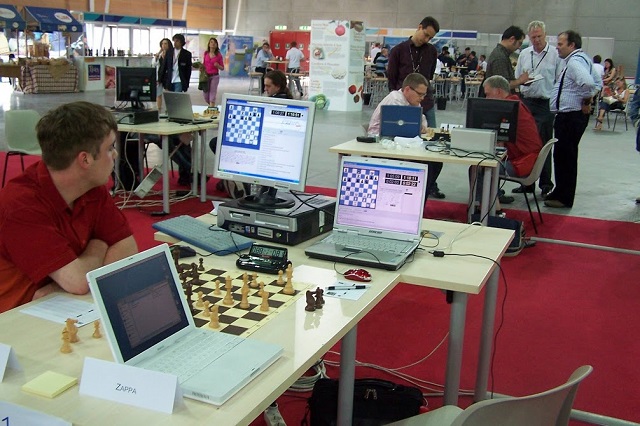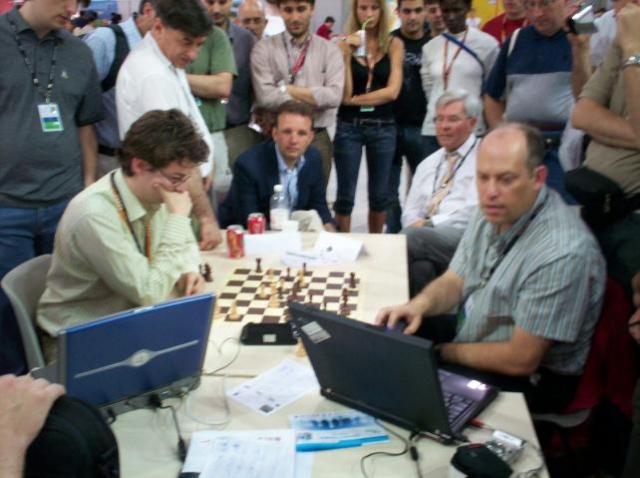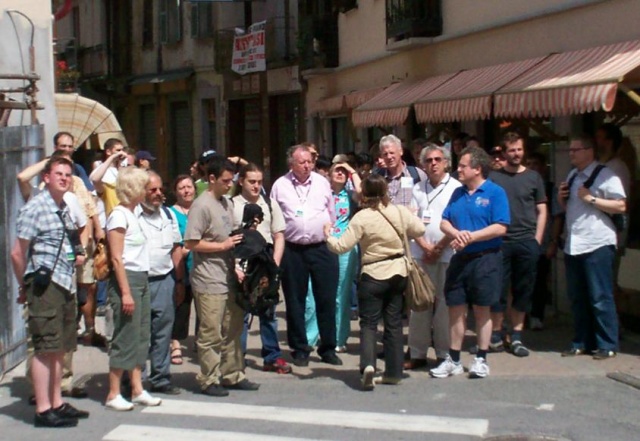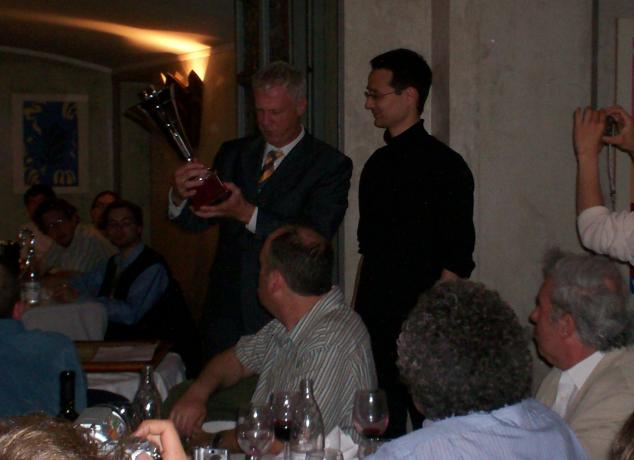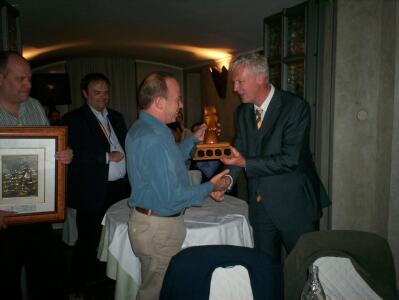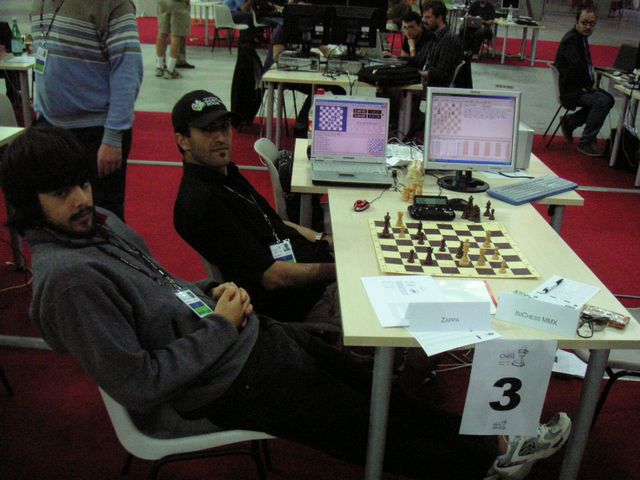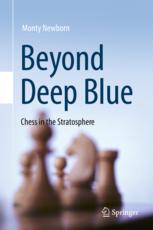WCCC 2006
Home * Tournaments * World Computer Chess Championship * 14th WCCC Turin 2006
The Fourteenth World Computer Chess Championship took place from May 25 to June 1, 2006, in the Oval Lingotto, Turin, Italy, in conjunction with the 11th Computer Olympiad [2], the 5th International Conference on Computers and Games [3] , and the human FIDE 37th Chess Olympiad. Local organizer of the WCCC and Computer Olympiad was Paolo Ciancarini from the University of Bologna.
Junior by Amir Ban and Shay Bushinsky did it again, also breaking the AMD 64 dominance with the Intel Core microarchitecture. Shredder by Stefan Meyer-Kahlen and Rybka aka Rajlich by Vasik Rajlich a half point behind. Reigning champion Zappa played on a cluster with 512 nodes. Naturally, their fourth, and after the Rybka disqualification in 2011, third place, did not met the expectations of Anthony Cozzie and book author Erdogan Günes.
Contents
Final Standing
14th World Computer Chess Championship 2006, Turin, IT [4]
| # | Program | CC | R1 | R2 | R3 | R4 | R5 | R6 | R7 | R8 | R9 | R10 | R11 | P | G | SOS | SoDOS |
|---|---|---|---|---|---|---|---|---|---|---|---|---|---|---|---|---|---|
| 1 | Junior | IL | 11b1 | 9w1 | 5b1 | 2w½ | 6b½ | 3w½ | 4b½ | 7w1 | 8b1 | 14w1 | 10b1 | 9 | 11 | 70½ | 55 |
| 2 | Shredder | DE | 10w1 | 8b1 | 3w1 | 1b½ | 4w½ | 7b½ | 6w1 | 5b½ | 12w1 | 13b½ | 15w1 | 8½ | 11 | 68½ | 51¼ |
| 3 | Rajlich [5] | HU | 13b1 | 6w1 | 2b0 | 4w½ | 8b1 | 1b½ | 7w½ | 11w1 | 18b1 | 17w1 | 9b1 | 8½ | 11 | 62½ | 42½ |
| 4 | Zappa | US | 7w½ | 16b1 | 12w1 | 3b½ | 2b½ | 6w½ | 1w½ | 9b1 | 5w1 | 10b½ | 8b½ | 7½ | 11 | 70 | 44¾ |
| 5 | Spike | DE | 12w½ | 7b1 | 1w0 | 8b½ | 16w1 | 9b½ | 14w1 | 2w½ | 4b0 | 11w½ | 17b1 | 6½ | 11 | 61 | 29 |
| 6 | Diep | NL | 17w1 | 3b0 | 10w1 | 16b1 | 1w½ | 4b½ | 2b0 | 8w0 | 11b1 | 18w1 | 12b½ | 6½ | 11 | 59½ | 25¾ |
| 7 | Jonny | DE | 4b½ | 5w0 | 14b1 | 12w1 | 13b1 | 2w½ | 3b½ | 1b0 | 15w1 | 8w0 | 18b1 | 6½ | 11 | 62½ | 28¾ |
| 8 | Crafty | US | 14b1 | 2w0 | 9b1 | 5w½ | 3w0 | 12b1 | 10w0 | 6b1 | 1w0 | 7b1 | 4w½ | 6 | 11 | 73 | 34½ |
| 9 | Ikarus | DE | 18w1 | 1b0 | 8w0 | 11b½ | 10w1 | 5w½ | 13b1 | 4w0 | 17b1 | 15b1 | 3w0 | 6 | 11 | 58 | 21 |
| 10 | IsiChess | DE | 2b0 | 15w1 | 6b0 | 14w1 | 9b0 | 11w0 | 8b1 | 18w1 | 13b1 | 4w½ | 1w0 | 5½ | 11 | 60½ | 21¼ |
| 11 | Delfi | IT | 1w0 | 17b1 | 16w0 | 9w½ | 12b½ | 10b1 | 15w1 | 3b0 | 6w0 | 5b½ | 14b1 | 5½ | 11 | 56½ | 21¾ |
| 12 | Chiron | IT | 5b½ | 13w1 | 4b0 | 7b0 | 11w½ | 8w0 | 18b1 | 17w1 | 2b0 | bye½ | 6w½ | 5 | 11 | 54 | 16¼ |
| 13 | ParSOS | DE | 3w0 | 12b0 | 18w1 | 15b1 | 7w0 | 17b1 | 9w0 | 14b1 | 10w0 | 2w½ | bye½ | 5 | 11 | 48 | 12¼ |
| 14 | Uragano 3D | IT | 8w0 | 18b1 | 7w0 | 10b0 | 17w1 | 15b1 | 5b0 | 13w0 | bye½ | 1b0 | 11w0 | 3½ | 11 | 48½ | 4½ |
| 15 | Chaturanga | IT | 16w0 | 10b0 | 17w1 | 13w0 | 18b1 | 14w0 | 11b0 | bye½ | 7b0 | 9w0 | 2b0 | 2½ | 11 | 44½ | 2 |
| 16 | Lion [6] | IT | 15b1 | 4w0 | 11b1 | 6w0 | 5b0 | - | - | - | - | - | - | 2 | 5 | 28½ | 8 |
| 17 | FIBChess | ES | 6b0 | 11w0 | 15b0 | 18w1 | 14b0 | 13w0 | bye½ | 12b0 | 9w0 | 1b0 | 5w0 | 1½ | 11 | 49½ | 0½ |
| 18 | EtaBeta | IT | 9b0 | 14w0 | 13b0 | 17b0 | 15w0 | bye½ | 12w0 | 10b0 | 3w0 | 6b0 | 7w0 | ½ | 11 | 50½ | 0 |
Participants
14th World Computer Chess Championship 2006, Turin, IT [7]
| Program | CC | Authors, Operators | Processor(s) | GHz |
|---|---|---|---|---|
| Chaturanga | IT | Stefano Malloggi | Intel 1x1 | 3.2 |
| Chiron | IT | Ubaldo Andrea Farina | AMD 1x1 | 2.2 |
| Crafty | US | Robert Hyatt, Peter Berger | AMD 4x2 | 2.4 |
| Delfi | IT | Fabio Cavicchio, Alex Brunetti (op) | Intel 1x1 | 3.0 |
| Diep | NL | Vincent Diepeveen, Eros Riccio | AMD 2x2 | 2.4 |
| EtaBeta | IT | Antonia Jeanrenaud | Intel 1x1 | 3.0 |
| FIBChess | ES | Guillermo Baches García | AMD 1x1 | 2.0 |
| Ikarus | DE | Munjong Kolss, Muntsin Kolss | AMD 2x2 | 1.8 |
| IsiChess | DE | Gerd Isenberg | AMD 2x1 | 2.2 |
| Jonny | DE | Johannes Zwanzger | AMD 1x2 | 2.5 |
| Junior | IL | Amir Ban, Shay Bushinsky | Intel 2x2 | 3.0 |
| Lion | IT | Giancarlo Delli Colli | ||
| ParSOS | DE | Rudolf Huber | AMD 1x1 | 2.0 |
| Rajlich | HU | Vasik Rajlich | AMD 4x2 | 2.4 |
| Shredder | DE | Stefan Meyer-Kahlen, Sandro Necchi | AMD 4x2 | 2.6 |
| Spike | DE | Volker Böhm, Ralf Schäfer, Timo Klaustermeyer (op) | AMD 2x2 | 2.6 |
| Uragano 3D | IT | Luca Naddei | AMD 1x1 | 2.0 |
| Zappa | US | Anthony Cozzie, Erdogan Günes | Intel 512x1 | 1.6 |
Photos
Round 1, Johannes Zwanzger and Zappa Laptops, behind Eros Riccio, Stefan Meyer-Kahlen, Gerd Isenberg
Munjong Kolss kibitzing, [unknown] and Jaap van den Herik talking with Paolo Ciancarini [9]
Erwin l'Ami sparring Junior operated by Shay Bushinsky
Ljubomir Ljubojević (standing), Jeroen Piket and Joop van Oosterom watching
Excursion in Susa, some people to recognize (from left to right):
Timo Klaustermeyer, Harry Nefkens, Antonia Jeanrenaud, Ubaldo Andrea Farina, Eros Riccio, Kevin O’Connell,
Johanna Hellemons, Jaap van den Herik, David Levy, Jonathan Schaeffer, Vasik Rajlich & Stefan Meyer-Kahlen
Jaap van den Herik awards the Blitz trophy to Munjong Kolss of Ikarus
Jaap van den Herik awards Amir Ban with the Shannon Trophy. First prize for Junior, Shay Bushinsky left
Photos & Games
Anthony Cozzie and Erdogan Günes frustrated about Zappa's draw vs. IsiChess in round 10 [10] [11]
[Event "WCCC 2006"] [Site "Turin, Italy"] [Date "2006.05.31"] [Round "10"] [White "IsiChess"] [Black "Zappa"] [Result "1/2-1/2"] 1.e4 c5 2.Nf3 d6 3.d4 cxd4 4.Nxd4 Nf6 5.Nc3 g6 6.Be3 Bg7 7.f3 O-O 8.Qd2 Nc6 9.O-O-O Bd7 10.g4 Rc8 11.h4 Qa5 12.Kb1 Ne5 13.h5 Nxf3 14.Nxf3 Rxc3 15.Qxc3 Qxc3 16.bxc3 Bxg4 17.Bg2 Nxe4 18.Rd3 Nxc3+ 19.Kb2 Nd1+ 20.Ka3 Nb2 21.Rb3 Nc4+ 22.Kb4 d5 23.Bxa7 Ra8 24.Bd4 Bxf3 25.hxg6 Bxd4 26.gxf7+ Kf8 27.Bxf3 e6 28.Rh4 Bf6 29.Rxh7 Ra6 30.Be2 Rb6+ 31.Ka4 Ra6+ 32.Kb4 Rb6+ 33.Ka4 Ra6+ 34.Kb4 1/2-1/2
On the Ground
The World Computer Chess Championship and Computer Olympiad as frame program of the human FIDE Chess Olympiad inside the Oval Lingotto, which was Speed skating location of the 2006 Winter Olympics a few months before, with most chess players staying in the near by the Olympic Village was tremendous. From the Village to Oval Lingotto was a huge pedestrian bridge over the railroad. During the 10 minute walk it was guaranteed to meet some famous chess players from all over the world. During the evening and night the surrounding streets, pubs, bars and restaurants were like Caïssa City, chess players and a few computer guys all over the place.
The Interpretation of Rules
Jaap van den Herik on the Lion case in The Interpretation of Rules, ICGA Journal, June 2006 [13]:
The LION++ 1.5 team made use of Fabien Letouzey’s program FRUIT. FRUIT is composed from open-source software and it unexpectedly finished in a second place in the 13th WCCC in Reykjavik, Iceland, last year. The LION++ 1.5 team members are honest people, they had checked our ruling with their legal advisors. It deals with rule 2 (see Vol. 29, No.1, p. 48) that states: “Each program must be the original work of the entering developers. Programming teams whose code is derived from or including game-playing code written by others must name all other authors, or the source of such code, in their application details. Programs which are discovered to be close derivatives of others (e.g., by playing nearly all moves the same), may be declared invalid by the Tournament Director after seeking expert advice. For this purpose a listing of all game-related code running on the system must be available on demand to the Tournament Director.”
In the tournament report you will find that one of the participants made a protest against LION++ 1.5. After inspection by Yngvi Björnsson and later (independently) by Jonathan Schaeffer it was clear that the code was similar to Letouzey’s. However, the remarkable thing was that the LION++ 1.5 team members did not deny this fact, but pointed: (a) to the credit for Letouzey as mentioned in their files, and (b) to all the newly developed routines which surrounded the ideas by Letouzey. Their interpretation of rule 2 diverged in three aspects from my interpretation. The aspects are: (1) original work, (2) application details, and (3) close derivatives. I discuss the three points briefly below.
(Ad 1) “original work of the entering developers”. If they had included Fabien Letouzey (with his permission) in the list of authors, there would have been no concerns. Since they had not done so, the discussion was on “original work”. Clearly, the main part of the program LION++ 1.5 was not their original work. However, rule 2 had five more lines, which the team perceived as an explanation of the notion “original” (see ad 2 and ad 3).
(Ad 2) “must name (....) in the application details”. The LION++ 1.5 team had interpreted “application” as ‘program’ and therefore they had included a file crediting the effort by Fabien Letouzey. Well done, but invisible for other people. Of course, the ICGA board had meant the ‘submission form’ should contain these names and credits. Then they could decide whether they would admit the program.
(Ad 3) “to be close derivatives”. Here the legal question arises: what is meant by “close”. The chief arbiter of the human Chess Olympiad, Geurt Gijssen, who has ample experience with World Championship matches, was consulted for interpretation. He pointed to the fact that when ‘close’ would mean “over 80 per cent”, it should be stated that way. Yet, the interpretation by Björnsson and, independently, by Schaeffer was that it was “a close derivative”.
Time Underflow
In the round 7 game, Crafty - IsiChess, the latter took profit from the sportsmanship of Crafty book author and operator Peter Berger, and the decision of TD Jaap van den Herik to allow IsiChess author Gerd Isenberg to switch ponder off and to push the space bar to force the move consistently displayed in the PV for about twenty minutes. Without that, IsiChess would have lost on time, but instead it even unjustly won the game from Crafty. Just after leaving the opening book while pondering, IsiChess displayed a huge average and maximum thinking time caused by a bug in time calculation with a "negative" thinking time [14].
[Event "WCCC 2006"] [Site "Turin, Italy"] [Date "2006.05.30"] [Round "7"] [White "Crafty"] [Black "IsiChess"] [Result "0-1"] 1.e4 c5 2.Nc3 Nc6 3.Nf3 d6 4.d4 cxd4 5.Nxd4 Nf6 6.f4 e6 7.Be3 a6 8.Qf3 Qc7 9.Qg3 Bd7 10.Be2 Be7 11.a3 O-O 12.O-O Rac8 13.Rad1 Kh8 14.Rfe1 h6 15.Kh1 b5 16.Nxc6 Bxc6 17.Bd4 Kg8 18.e5 dxe5 19.Bxe5 Qb7 20.Bd3 Nh5 21.Qg4 Nf6 22.Qh3 Nd7 23.Bd4 Bc5 24.Ne2 Bxd4 25.Nxd4 Bd5 26.c3 Rfd8 27.Rd2 Qc7 28.Qh4 Qd6 29.Bc2 Nf6 30.Re5 Kf8 31.Rd1 Qc7 32.Re2 Rd7 33.Rde1 Re8 34.Kg1 Bb7 35.Bb3 Rde7 36.Re5 Qb6 37.Kh1 Qd8 38.Qg3 Nd7 39.R5e2 Nf6 40.Re5 Nd7 41.R5e2 Nf6 42.a4 b4 43.Re5 Nd7 44.R5e2 bxc3 45.bxc3 Nf6 46.Re5 Qc7 47.R1e2 Bd5 48.Bc2 Qb6 49.Re1 Qb2 50.R5e3 Bb7 51.Rb1 Qa3 52.Rd1 Rc8 53.f5 e5 54.Rxe5 Rxc3 55.Qe1 Rcc7 56.Re2 Nd5 57.Be4 Qxa4 58.Bxd5 Bxd5 59.h3 Rxe2 60.Nxe2 Rc5 61.Rd4 Qc6 62.Qg3 Kg8 63.Nf4 Qc7 64.Qg4 Bb7 65.Ne2 Rb5 66.Nf4 Qa5 67.Rd7 Bc8 68.Re7 Bxf5 69.Qg3 Qd8 70.Qe3 Qd6 71.Ne2 Bd7 72.Re4 Rb1+ 73.Ng1 Rd1 74.Qc3 Bc6 75.Rc4 Bb7 76.Rg4 g5 77.Qb3 Bc6 78.h4 Bd5 79.Qc2 f5 80.Ra4 Kg7 81.Qf2 Bc6 82.Rc4 Be4 83.hxg5 Rd2 84.Qa7+ Kg6 85.Rxe4 fxe4 86.gxh6 Kxh6 87.Qe3+ Kg7 88.Qxe4 Rd1 89.Qb7+ Kh6 90.Qb2 Qd4 91.Qxd4 Rxd4 92.Ne2 Rc4 93.Kg1 a5 94.Kf2 a4 95.Ke3 a3 0-1
See also
Publications
- Jaap van den Herik (2006). The Interpretation of Rules. Editorial, ICGA Journal, Vol. 29, No. 2, pdf
- Jaap van den Herik, Johanna Hellemons (2006). The 14th World Computer Chess Championship. ICGA Journal, Vol. 29, No. 2
- Eric Hallsworth (2006). The 2006 World Computer Championships. Selective Search 125, pp. 29, pdf hosted by Mike Watters
- Monty Newborn (2011). Beyond Deep Blue: Chess in the Stratosphere. Springer, ISBN-13: 978-0857293404, amazon
- Chapter 10 2006: Junior, Another Comeback Kid, Wins 14th WCCC
Forum Posts
- ICGA rule #2 / opening books / Diep-Crafty, Turino 2006 by Peter Berger, CCC, October 22, 2011 » Opening Book
External Links
- 14th World Computer Chess Championship from the ICGA Tournament Database
- How Deep Junior conquered Turin by Shay Bushinsky, ChessBase News, August 07, 2006
- Shredder Computer Chess Download - Computer Chess World Championship in Torino report by Stefan Meyer-Kahlen
- Johannes Zwanzger in Turin, May 24, 2006 (German) (Wayback Machine)
- Johannes Zwanzger in Turin, May 25, 2006 (German)
- Johannes Zwanzger in Turin, May 29, 2006 (German)
- Johannes Zwanzger in Turin, May 31, 2006 (German)
- Johannes Zwanzger in Turin, June 01, 2006 (German)
References
- ↑ Oval Lingotto, Image by Luca Galli, May 13, 2011, CC BY 2.0, Oval Lingotto - Wikipedia.it
- ↑ Computer Olympiad in Torino, Italy by Hiroshi Yamashita
- ↑ Computer and Games Conference CG2006
- ↑ 14th World Computer Chess Championship - Turin 2006 (ICGA Tournaments)
- ↑ Disqualified 2011
- ↑ Disqualified 2006, based on Fruit as mentioned in the Readme-file, but not in the entry form
- ↑ 14th World Computer Chess Championship - Turin 2006 (ICGA Tournaments)
- ↑ Photos by Shaun Press and Gerd Isenberg
- ↑ Photo by Papua New Guinean 37th Chess Olympiad participant and computer chess programmer Shaun Press, his Turin Olympiad 2006 Photos
- ↑ Computer Olympiad in Torino, Italy, Photo gallery by Hiroshi Yamashita
- ↑ Turin 2006 - Chess - Round 10 - Game 3 (ICGA Tournaments)
- ↑ Elegante Brücke beim Olympischen Dorf, Schacholympiade 2006 in Turin, Photo courtesy by Gerhard Hund, Photographer: Barbara Hund
- ↑ Jaap van den Herik (2006). The Interpretation of Rules. Editorial, ICGA Journal, Vol. 29, No. 2, pdf
- ↑ Turin 2006 - Chess - Round 7 - Game 5 (ICGA Tournaments)
